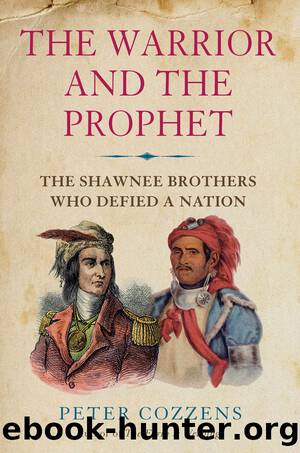The Warrior and the Prophet by Peter Cozzens

Author:Peter Cozzens
Language: eng
Format: epub
Publisher: Atlantic Books
Tenskwatawaâs abuse of the Delaware envoys exasperated Harrison. âI cannot account for the conduct of the Prophet upon any rational principle,â he wrote Eustis. âNothing now remains but to chastise him, and he shall certainly get it.â On October 29, Harrison marched cautiously north from Fort Harrison. Rather than follow the old Indian trail up the southeast bank of the Wabash, he forded the river and took a roundabout route to Prophetstown through trackless prairie. On a cold and rainy November 1, Harrisonâs army splashed across the Little Vermillion River and entered Indian land, on which, by the terms of every treaty negotiated to date, Indians were free to congregate as they pleased, subject only to the acquiescence of neighboring tribes, on the condition that they commit no violence against legally settled white neighbors.
Disallowing the doubtful claim that the Prophet was behind the recent raids in the Illinois and Indiana territories, Harrison was clearly the aggressor. Perhaps mindful that political opponents would raise objections, he made a final attempt to avert bloodshed. Before crossing the Wabash River, he prevailed on the Delaware chiefs to send three or four men with another message to the Prophet, a mission that the Miamis endorsed and to which they also contributed two dozen chiefs and warriors. Harrisonâs terms were tantamount to a surrender of all for which the Shawnee brothers had strived. The Winnebagos, Potawatomis, and Kickapoos, who constituted three-quarters of the Prophetstown warrior population, were to return to their respective tribes. The Prophet was to deliver up the stolen horses Harrison assumed he had and turn over the âmurderers of our citizensâ or offer âsatisfactory proofs that they were not under his control.â13
The Delaware and Miami troop entered an Indian community roiled by internal conflict. The Potawatomis were divided between Shabbonaâs small moderate faction and a larger contingent under Chief Wabaunsee, who had demonstrated his desire to kill white men by swimming out to an army keelboat on the Wabash two days earlier and tomahawking and scalping a crew member. The Winnebagos clamored for a fight, the Kickapoos were ready to take up arms if necessary, and Chief Roundheadâs contingent of Wyandots likely deferred to the Shawnee Prophet.
Confronted with factious followers, Tenskwatawa temporized. He expected Harrison to approach along the southeast side of the Wabash opposite the village. With the river as a barrier, Tenskwatawa hoped to stall him until Wyandot and Ojibwa warriors who were expected from the Michigan Territory arrived. He also agreed to a council. Unfortunately for him, however, the Delawares and Miamis were unaware that Harrison had crossed the Wabash. Less several Miamis who elected to cast their lot with the Prophet, the emissaries forded the churning Wabash beneath a hard, cold rain and started up the wrong bank. Harrison would next see them several months later.14
Download
This site does not store any files on its server. We only index and link to content provided by other sites. Please contact the content providers to delete copyright contents if any and email us, we'll remove relevant links or contents immediately.
Machine Learning at Scale with H2O by Gregory Keys | David Whiting(4184)
Never by Ken Follett(3794)
Harry Potter and the Goblet Of Fire by J.K. Rowling(3775)
Unfinished: A Memoir by Priyanka Chopra Jonas(3333)
Fairy Tale by Stephen King(3220)
The Man Who Died Twice by Richard Osman(2997)
Will by Will Smith(2794)
Rationality by Steven Pinker(2291)
The Dark Hours by Michael Connelly(2245)
Can't Hurt Me: Master Your Mind and Defy the Odds - Clean Edition by David Goggins(2228)
It Starts With Us (It Ends with Us #2) by Colleen Hoover(2199)
The Storyteller by Dave Grohl(2172)
The Dawn of Everything: A New History of Humanity by David Graeber & David Wengrow(2122)
Friends, Lovers, and the Big Terrible Thing by Matthew Perry(2119)
The Becoming by Nora Roberts(2088)
The Stranger in the Lifeboat by Mitch Albom(2050)
Cloud Cuckoo Land by Anthony Doerr(2035)
Einstein: His Life and Universe by Walter Isaacson(1967)
Love on the Brain by Ali Hazelwood(1965)
